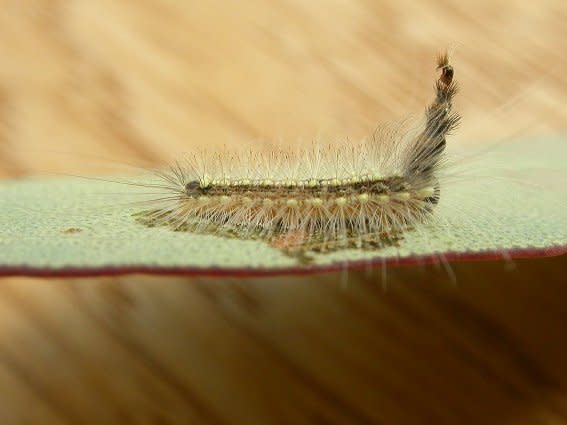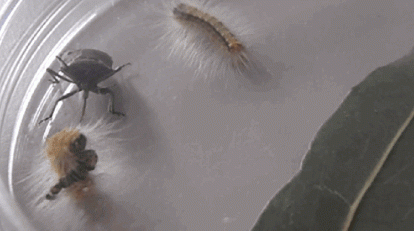This caterpillar has a brutal method for warding off predators

Donald Hobern/Wikimedia Commons; CC
Fashion trends can sometimes spawn some fairly questionable items of clothing, but none can be as strange as that worn by a very peculiar caterpillar.
This little critter is called the gum leaf skeletoniser, and it crawls around with a stack of old "skulls" on its head. The question, of course, is why?
As a new study in PeerJ reveals, this grim head ornamentation is used to fend off predators.
Researchers know that these horns are the remains of old head skin that it has molted as it has grown bigger over time.
An organized little fellow, this caterpillar – known scientifically as Uraba lugens – stacks these skulls from the smallest and youngest at the top to the most recent at the base.
It’s not clear how the stack remains stable, but it may have something to do with a ring of head hairs that act as an anchor of sorts. Regardless, this sinister skull-stacking is a decidedly strange way to behave – after all, most insects simply discard or even eat their molted skin.
A previous paper by lead author Petah Low – a behavioral ecologist at the University of Sydney – discovered that, when provoked, these creatures appeared to use their horrendous headgear to protect their backs from physical attack. In order to confirm this theory, she arranged for several of them to enter their equivalent of a gladiatorial arena.
Two were placed in a petri dish – one with a skull stack and one without – along with a predatory stinkbug, which injects death-bringing toxins through its needle-shaped mouth into its prey. Caterpillars without any head protection died in around 14 seconds, whereas those with the head horn lasted for around 120 seconds before the stinkbug overcame their defenses.

Donald Hobern/Wikimedia Commons; CC
Low noticed that the toxic aggressor often tended to attack the skull stack instead of the caterpillar’s body, implying that this hat of death temporarily confused it. In what resembled an insect-based version of a sword fight, the skull stack was sometimes used to deflect the stinkbug’s needle-like appendage away from the caterpillar’s vulnerable back.
Six hundred of these caterpillars were also placed onto the leaves of wild gum trees – the type they normally feast on in large numbers. One group of them had a mix of horn-adorned and hornless heads, another had no horns, and the last bunch were allowed to keep their discarded skull collections.
After being left for just eight days, only a sixth were left alive. Curiously, the horn-filled group members were no more likely to survive than those in the hornless group. Within the mixed group, those with horns were twice as likely to survive as those without.
This suggests that just having a skull stack isn’t enough – those with the most fearsome head horns were the most likely to survive, even in large groups. So perhaps in this case, size does matter.
NOW WATCH: The weird economic reason drug cartel members get head-to-toe tattoos
See Also:


